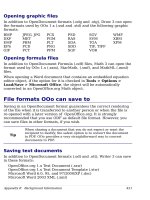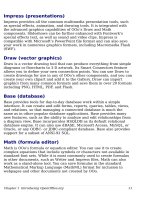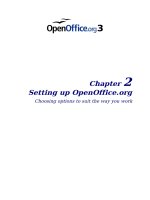Getting Started with Open Office .org 3 part 39 ppsx
Bạn đang xem bản rút gọn của tài liệu. Xem và tải ngay bản đầy đủ của tài liệu tại đây (4.77 MB, 10 trang )
Macros container. The My Macros container is stored in your user area
or home directory.
If a macro is contained in a document, then a recorded macro will
attempt to work on that document; primarily because it uses
“ThisComponent” for its actions.
Every library container contains a library named
Standard
. It is better
to create your own libraries with meaningful names than to use the
Standard library. Not only are meaningful names easier to manage, but
they can also be imported into other library containers whereas the
Standard library cannot.
Caution
OpenOffice.org allows you to import libraries into a library
container, but it will not allow you to overwrite the library
named Standard. Therefore, if you store your macros in the
Standard library, you cannot import them into another
library container.
Just as it makes good sense to give your libraries meaningful names, it
is prudent to use meaningful names for your modules. By default,
OpenOffice.org uses names such as Module1. Feel free to use your own
meaningful name.
As you create your macros, you must decide where to store them.
Storing a macro in a document is useful if the document will be shared
and you want the macro to be included with the document. Macros
stored in the application library container named My Macros, however,
are globally available to all documents.
Macros are not available until the library that contains them is loaded.
The Standard library and Template library, however, are automatically
loaded. A loaded library is displayed differently from a library that is
not loaded. To load the library and the modules it contains, double-
click on the library.
Where are macros stored?
OpenOffice.org stores user-specific data in a directory under the user’s
home directory. For example, on Windows, this is C:\Documents and
Settings\<name>\Application Data. User macros are stored in
OpenOffice.org2\user\basic. Each library is stored in its own directory
off the basic directory.
It is not important to understand where macros are stored for casual
use. If you know where they are stored, however, you can create a
backup, share your macros, or inspect them if there is an error. For
Chapter 13 Getting Started with Macros 381
example, on one or more of my OpenOffice.org upgrades, all of my
macros disappeared. Although the macros were still on disk, the
macros were not copied to the new directories. The solution was to
import the macros into the new installation.
Use Tools > Macros > Organize Dialogs to open the OpenOffice.org
Macros organizer dialog. Another common way to open this dialog is to
use Tools > Macros > Organize Macros > OpenOffice.org Basic
to open the OpenOffice.org Macros dialog and then click the
Organizer button (see Figure 320).
Figure 320: The macro organizer dialog
Importing macros
The OpenOffice.org Macro Organizer dialog provides functionality to
create, delete, and rename libraries, modules, and dialogs. Select the
library container to use and then click the Import button to import
macro libraries (see Figure 321).
Tip
You cannot import the library named Standard.
Tip
On Linux, the OpenOffice.org-specific files are stored in a
directory whose name begins with a period. Directories and
files with names beginning with a period are not shown in a
normal selection dialog. To open the directory, I navigated to
the parent directory, entered the name .openoffice.org2.0, and
then clicked Open. This opened the directory, which was not
initially shown.
382 Getting Started with OpenOffice.org 3
Figure 321: Select a macro library to import
Navigate to the directory containing the library to import. There are
usually two files from which to choose, dialog.xlb and script.xlb. It does
not matter which of these two files you select; both will be imported.
Select a file and click Open to continue (see Figure 322).
Figure 322: Choose library import options
If the library already exists, it will not be replaced unless Replace
existing libraries is checked. If Insert as reference is checked, the
library is referenced in its current location, but you cannot edit the
library. If Insert as reference is not checked, however, the library is
copied to the user’s macro directory.
Macros can be stored in libraries inside OpenOffice.org documents.
Select a document rather than a directory on disk (as shown in Figure
321) to import libraries contained in a document.
Chapter 13 Getting Started with Macros 383
Downloading macros to import
Macros are available for download. Some macros are contained in
documents, some as regular files that you must select and import, and
some as macro text that should be copied and pasted into the Basic
IDE; use Tools > Macros > Organize Macros > OpenOffice.org
Basic to open the OpenOffice.org Macros dialog, choose the macro to
edit, and then click Edit to open the macro in the Basic IDE.
Some macros are available as free downloads on the Internet (see
Table 3).
Table 3. Places to find macro examples.
Location Description
Excellent collection of packaged
macros.
Reference materials regarding macros.
Reference materials regarding
database macros.
Lots of links to everything.
Many examples and help.
How to run a macro
A typical method to run a macro is as follows:
1) Use Tools > Macros > Run Macro to open the Macro Selector
dialog (see Figure 323).
2) Select the library and module in the Library list (left hand side).
3) Select the macro in the Macro name list (right hand side).
4) Click Run to run the macro.
384 Getting Started with OpenOffice.org 3
Figure 323: Use the Macro Selector dialog to run macros
Although you can use Tools > Macros > Run Macro to run all
macros, this is not efficient for frequently run macros. A more common
technique is to assign a macro to a toolbar button, menu item,
keyboard shortcut, or a button embedded in a document. While
choosing a method, it is also good to ask questions such as:
• Should the macro be available for only one document, or globally
for all documents?
• Does the macro pertain to a specific document type, such as a
Calc document?
• How frequently will the macro be used?
The answers will determine where to store the macro and how to make
it available. For example, you will probably not add a rarely used
macro to a toolbar. To help determine your choices, see Table 4.
Table 4. Methods for starting a macro.
Type OpenOffice.org Document Type Document
Toolbar No Yes Yes
Menu No Yes Yes
Shortcut Yes Yes No
Event Yes No Yes
Chapter 13 Getting Started with Macros 385
To add a menu item, keyboard shortcut, or toolbar icon that calls a
macro, use the Customize dialog (see Figure 325). Open this dialog in
either of these ways:
• Choose Tools > Customize from the main menu bar.
• Each toolbar has an icon that opens a menu; choose the
Customize Toolbar option.
Tip
Complete coverage of the Customize dialog is beyond the
scope of this document. Click the Help button to access the
help pages included with OpenOffice.org.
The Customize dialog contains tabs to configure menus, keyboard
bindings, toolbars, and events.
Figure 324: OpenOffice.org Customize dialog
386 Getting Started with OpenOffice.org 3
Toolbar
Macros can be added to toolbars. For more about modifying toolbars,
see Chapter 14 (Customizing OpenOffice.org).
Menu item
Use Tools > Customize to open the Customize dialog, and select the
Menus tab. You can modify an existing menu, or create new menus that
call macros. For more about modifying menus, see Chapter 14.
Keyboard shortcuts
Use Tools > Customize to open the Customize dialog, and select the
Keyboard tab. Assigning keyboard shortcuts is discussed in Chapter 14.
Event
In OpenOffice.org, when something happens, we say that an event
occurred. For example, a document was opened, a key was pressed, or
the mouse moved. OpenOffice.org allows events to cause a macro to be
called; the macro is then called an event handler. Full coverage of
event handlers is well beyond the scope of this document, but a little
knowledge can accomplish much.
Caution
Be careful when you configure an event handler. For
example, assume that you write an event handler that is
called every time that a key is pressed, but you make a
mistake so the event is not properly handled. One possible
result is that your event handler will consume all key
presses, forcing you to forcibly terminate OpenOffice.org.
Use Tools > Customize to open the Customize dialog, and select the
Events tab (see Figure 325). The events in the Customize dialog are
related to the entire application and specific documents. Use the Save
In box to choose OpenOffice.org, or a specific document.
Chapter 13 Getting Started with Macros 387
Figure 325: Assign macro to an application level event
A common use is to assign the Open Document event to call a specific
macro. The macro then performs certain setup tasks for the document.
Select the desired event and click the Macro button to open the Macro
Selector dialog (see Figure 326).
Select the desired macro and click OK to assign the macro to the
event. The Events tab shows that the event has been assigned to a
macro (see Figure 327). When the document opens, the PrintHello
macro is run.
Many objects in a document can be set to call macros when events
occur. The most common usage is to add a control, such as a button,
into a document. Even double-clicking on a graphic opens a dialog with
a Macros tab that allows you to assign a macro to an event.
388 Getting Started with OpenOffice.org 3
Figure 326: Assign macro to the document open event
Figure 327: PrintHello is assigned to the Open Document event
Extensions
An extension is a package that can be installed into OpenOffice.org to
add new functionality. Extensions can be written in almost any
programming language and may be simple or sophisticated. Extensions
can be grouped into types:
• Calc Add-Ins, which provide new functionality for Calc, including
new functions that act like normal built-in functions
• New components and functionality, which normally include some
level of UI integration such as new menus or toolbars
• Data pilots that are used directly in Calc
• Chart Add-Ins with new chart types
• Linguistic components such as spell checkers
• Document templates and images
Chapter 13 Getting Started with Macros 389
Although individual extensions can be found in different places, there
is an extension repository at: />For more about obtaining and installing extensions, see Chapter 14
(Customizing OpenOffice.org).
Writing macros without the recorder
The examples covered in this chapter are created using the macro
recorder and the dispatcher. You can also write macros that directly
access the objects that comprise OpenOffice.org. In other words, you
can directly manipulate a document.
Directly manipulating OOo’s internal objects is an advanced topic that
is beyond the scope of this chapter. A simple example, however,
demonstrates how this works.
Listing 4: Append the text “Hello” to the current document.
Sub AppendHello
Dim oDoc
Dim sTextService$
Dim oCurs
REM ThisComponent refers to the currently active document.
oDoc = ThisComponent
REM Verify that this is a text document
sTextService = "com.sun.star.text.TextDocument"
If NOT oDoc.supportsService(sTextService) Then
MsgBox "This macro only works with a text document"
Exit Sub
End If
REM Get the view cursor from the current controller.
oCurs = oDoc.currentController.getViewCursor()
REM Move the cursor to the end of the document
oCurs.gotoEnd(False)
REM Insert text "Hello" at the end of the document
oCurs.Text.insertString(oCurs, "Hello", False)
End Sub
390 Getting Started with OpenOffice.org 3









